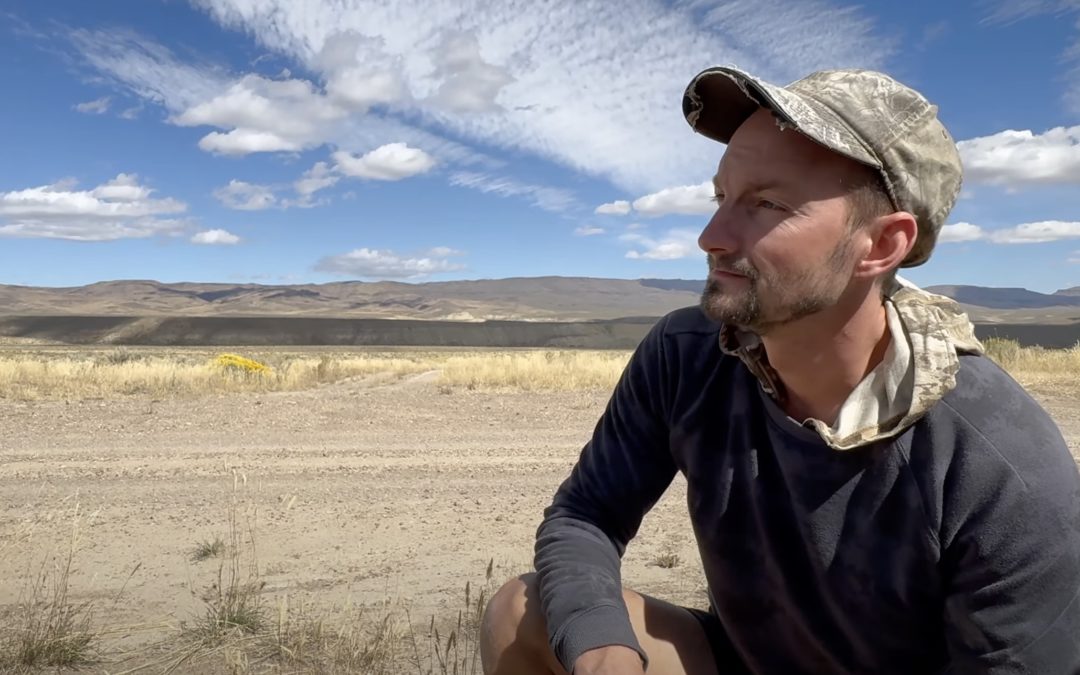Mountaintop removal for lithium to go into electric vehicle batteries is ecocide, just like mountaintop removal for coal mining is.
Earlier this week, I visited the site of yet another planned open pit lithium mine that is threatening the Great Basin — this time, in the state of Oregon. This site, about 15 miles north of Thacker Pass, is vital habitat for the Lahontan cutthroat trout, sage grouse, and countless other species — and it would be completely destroyed if the mine is built.
Yes, global warming is a crisis, and yes, we must stop burning fossil fuels. But this is not the way forward. This is an addict seeking another hit. The “green” energy economy destroys the planet, same as the old fossil fuel energy economy. This project is another greenwashing lie, just as we wrote about in “Bright Green Lies.” If you want a primer, read that book and watch the film version of “Bright Green Lies” and Jeff Gibb’s “Planet of the Humans.”
In honor of the late Utah Phillips, I’ve listed the names and addresses of the people who run Jindalee Corporation on a previous Substack article.
To stay up to date and get involved, please visit Protect Thacker Pass and signup for our email updates.
Transcript
So we’re here at the site of the proposed HiTech Minerals / Jindalee Corporation lithium mine. This is the next lithium project coming to the McDermitt Caldera. We’re sitting here at the north end of the Caldera, so this big rim of mountains all the way around us, this is surrounding what is now a basin at the north end of the Caldera which collapsed; like Crater Lake is the Caldera of what was once Mount Mazama that then collapsed. Similarly, here we have this lowered down Caldera and in here is the lithium, all through the soils of this region. The mining company has already been doing some test drilling up in the hills up here, checking out how much lithium there is in the soil and gathering the data that they need to figure out if it’s economically feasible to do their project. Unfortunately I think it likely will be, although we’ll see. This project is likely at least several years behind the Thacker Pass lithium mine in terms of progress, probably more like three or four years behind, but it’s coming, and right now there’s a permitting process that they’re engaged in with the BLM office based in Vale, Oregon to try to get a permit for additional test drilling out here. They want to do test drilling for four or five years, I believe six or seven months out of the year, 24/7. And so they would stop in the winter time and in the early spring but other than that they would be drilling 24 hours a day, seven days a week out here with multiple drilling rigs operating at a time.
Right now, this area is not pristine as you can see right behind me. We’re on a road right now. This area has been grazed. There is some impact to this area, but this is still intact land. And what I was thinking of before I decided to pull out the camera and record this video is how the dominant culture has this sort of progressive escalation of exploitation. So first they’ll come into an area, and if it’s a forest they’ll cut down the trees and they’ll exploit that for what wealth they can generate; then they’ll convert it to agriculture and exploit the soil for what wealth it can generate; then if there’s greater wealth available by developing it for housing or building a town or something like that, they’ll do that. And so that’s what we’re seeing here. This area has been used for cattle grazing for many years. And now the next level of exploitation is pending as we speak.
The area that they’re surveying is about six miles east to west and about four miles north to south. It’s a very significant area out here. There’s also two other lithium companies that are prospecting for lithium in the same basin within just a few miles of where we sit, further east on the east side of the Jindalee project. So there could be three separate lithium mines operating in this location in the future. Over the last couple days we drove over the top of the Montana Mountains south from here to the top of Thacker Pass, overlooking Thacker Pass, and that whole way there’s lithium claims – mining companies have staked lithium claims for lithium up there, including Lithium Americas Corporation. So there is a very real possibility that over the coming decades this entire landscape could become an industrialized sacrifice zone, and we’re talking about an area that’s something like 25 miles north to south and 10 miles wide – a huge region.
This is incredibly important habitat. We were just down at McDermitt Creek which is vital habitat for the Lahontan cutthroat trout, a threatened fish species listed under the Endangered Species Act. This is vital habitat for Sage-Grouse. We’ve seen about eight female Sage-Grouse on the trip so far. They use this area – there are “leks” in this area where they do their breeding. Those will be abandoned if there’s too much disturbance in this area. There’s pronghorn antelope out here, mule deer, all kinds of wildlife. And up in these mountains all around us are wilderness areas. There’s something like one, two, three, four, five separate wilderness areas surrounding us right now in a big arc on the west side, the south-west, and up here to the north. Those wilderness areas have some protection, which is excellent, but that protection doesn’t mean that much if all the connectivity corridors between them, all the lands around them are industrialized, if you have all this air pollution being generated right below them that’s going directly onto the waterways and the forests that hang on to the slopes of these high mountains up here.
And of course, this is also a very culturally important area, traditionally. We’re only a few miles from the Fort McDermitt Paiute Shoshone reservation. But, you know, the reservation system was created after colonization and prior to that there was no such thing as the Fort McDermitt tribe. There were these different bands of the local indigenous nations and those bands have been scattered and they have interrelationships. So the people whose ancestors spent time and lived on this terrain are at Burns Paiute Tribe, they’re at Fort McDermitt, they’re at Reno Sparks, they’re at the Pyramid Lake Tribe, they’re in Duck Valley. They’re all over these different reservations, these different tribes, modern tribes that we have now. And so this is a culturally very important place.
And what I’m hoping we’ll see here, what we didn’t see at Thacker Pass, is a growing resistance to this project starting early. Thacker Pass was snuck through by the Trump administration during the height of Covid. They expedited the permitting to try to avoid democracy basically, to try to avoid input from the people. And so we have a chance now with this project being more in the early stages to have more input and to have a chance to stop this thing before it even starts. They’ve already done some damage with the drilling and they can’t put that right. They’re supposed to “remediate” it. Basically their remediation consists of heaping some soil across the road and a few rocks so that hopefully nobody drives on the road that they created, and throwing out some seeds and hoping that they germinate. It’s basically a joke. So that damage has been done. There’s more drilling probably coming up soon, but I want folks to stay tuned, you know? We’ve been working to protect Thacker Pass and us and many other groups and individuals are going to be working to protect the Mcdermitt Caldera as a whole. And we’re going to need your help.


Recent Comments